![[DBPP]](pictures//asm_color_tiny.gif)





![[Search]](pictures//search_motif.gif)
Next: 2.6 Case Study: Atmosphere Model
Up: 2 Designing Parallel Algorithms
Previous: 2.4 Agglomeration
In the fourth and final stage of the parallel algorithm design
process, we specify where each task is to execute. This mapping
problem does not arise on uniprocessors or on shared-memory computers
that provide automatic task scheduling. In these computers, a set of
tasks and associated communication requirements is a sufficient
specification for a parallel algorithm; operating system or hardware
mechanisms can be relied upon to schedule executable tasks to
available processors. Unfortunately, general-purpose mapping
mechanisms have yet to be developed for scalable parallel computers.
In general, mapping remains a difficult problem that must be
explicitly addressed when designing parallel algorithms.
Our goal in developing mapping algorithms is normally to minimize
total execution time. We use two strategies to achieve this goal:
-
We place tasks that are able to execute concurrently on
different
processors, so as to enhance concurrency.
-
We place tasks that communicate frequently on the same
processor, so as to increase locality.
Clearly, these two strategies will sometimes conflict, in which case
our design will involve tradeoffs. In addition, resource limitations
may restrict the number of tasks that can be placed on a single
processor.
The mapping problem is known to be NP
-complete, meaning that no
computationally tractable (polynomial-time) algorithm can exist for
evaluating these tradeoffs in the general case. However, considerable
knowledge has been gained on specialized strategies and heuristics and
the classes of problem for which they are effective. In this
section, we provide a rough classification of problems and present
some representative techniques.
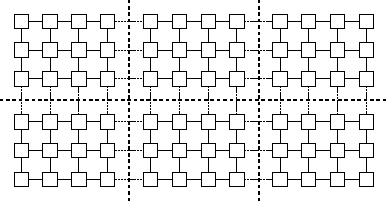
Figure 2.16: Mapping in a grid problem in which each task performs the
same amount of computation and communicates only with its four
neighbors. The heavy dashed lines delineate processor boundaries.
The grid and associated computation is partitioned to give each
processor the same amount of computation and to minimize off-processor
communication.
Many algorithms developed using domain decomposition techniques
feature a fixed number of equal-sized tasks and structured local and
global communication. In such cases, an efficient mapping is
straightforward. We map tasks in a way that minimizes interprocessor
communication (Figure 2.16); we may also choose to agglomerate
tasks mapped to the same processor, if this has not already been done,
to yield a total of P
coarse-grained tasks, one per processor.
In more complex domain decomposition-based algorithms with variable
amounts of work per task and/or unstructured communication patterns,
efficient agglomeration and mapping strategies may not be obvious to
the programmer. Hence, we may employ
load balancing
algorithms that seek to identify efficient
agglomeration and mapping strategies, typically by using heuristic
techniques. The time required to execute these algorithms must be
weighed against the benefits of reduced execution time.
Probabilistic load-balancing
methods tend to have lower overhead
than do methods that exploit structure in an application.
The most complex problems are those in which either the number of
tasks or the amount of computation or communication per task changes
dynamically during program execution. In the case of problems
developed using domain decomposition techniques, we may use a
dynamic load-balancing
strategy in which a load-balancing
algorithm is executed periodically to determine a new agglomeration
and mapping. Because load balancing must be performed many times
during program execution,
local
algorithms may be preferred that do not require
global knowledge of computation state.
Algorithms based on functional decomposition often yield computations
consisting of many short-lived tasks that coordinate with other tasks
only at the start and end of execution. In this case, we can
use task-scheduling
algorithms, which allocate tasks to
processors that are idle or that are likely to become idle.
A wide variety of both general-purpose and application-specific
load-balancing techniques have been proposed for use in parallel
algorithms based on domain decomposition techniques. We review
several representative approaches here (the chapter notes provide
references to other methods), namely recursive bisection methods,
local algorithms, probabilistic methods, and cyclic mappings. These
techniques are all intended to agglomerate fine-grained tasks defined
in an initial partition to yield one coarse-grained task per
processor. Alternatively, we can think of them as partitioning our
computational domain to yield one subdomain
for each processor. For this reason, they are often referred to as
partitioning
algorithms.
Recursive bisection techniques are used to partition a domain (e.g., a
finite element grid) into subdomains of approximately equal
computational cost while attempting to minimize communication costs,
that is, the number of channels crossing task boundaries. A
divide-and-conquer approach is taken. The domain is first cut in one
dimension to yield two subdomains. Cuts are then made recursively in
the new subdomains until we have as many subdomains as we require
tasks. Notice that this recursive strategy allows the
partitioning algorithm itself to be executed in parallel.
The most straightforward of the recursive bisection techniques is
recursive coordinate bisection, which is normally applied to
irregular grids that have a mostly local communication structure.
This technique makes cuts based on the physical coordinates of grid
points in the domain, at each step subdividing along the longer
dimension so that if (for example) the cut is made along the
x
dimension, grid points in one subdomain will all have an
x
-coordinate greater than grid points in the other. This
approach has the advantages of being simple and inexpensive. It also
does a good job of partitioning computation. A disadvantage is that
it does not optimize communication performance. In particular, it can
generate long, skinny subdomains, which if an algorithm has
significant local communication will result in more messages than will
a decomposition that generates square subdomains.
A variant of recursive bisection called unbalanced recursive
bisection
attempts to reduce communication costs by forming
subgrids that have better aspect ratios. Instead of automatically
dividing a grid in half, it considers the P-1
partitions
obtained by forming unbalanced subgrids with 1/P
and
(P-1)/P
of the load, with 2/P
and (P-2)/P
of the
load, and so on, and chooses the partition that minimizes partition
aspect ratio. This method increases the cost of computing the
partition but can reduce communication costs.
Plate 1
shows a mapping onto 64 processors constructed by using unbalanced
recursive bisection. In this instance, the grid in question is an
irregular finite element mesh generated for a superconductivity
simulation.
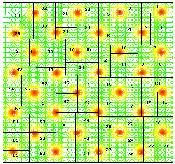
(GIF 235573 bytes; RGB 1142568 bytes.)
Plate 1: The unbalanced recursive bisection algorithm, applied here to a
superconductivity simulation in which increased computational load
corresponds to an increased number of triangular elements in certain
areas of the grid. The recursive partitioning yields sixty four
subdomains, with for example the first partition descending vertically
between subdomains 28 and 5. Image courtesy of P. Plassmann.
Another technique, called recursive graph bisection
, can be
useful in the case of more complex unstructured grids, for example,
finite element meshes. This technique uses connectivity information
to reduce the number of grid edges crossing subdomain boundaries, and
hence to reduce communication requirements. A grid is treated as a
graph with N
vertices (grid points)  . The algorithm first
identifies the two extremities of the graph, that is, the two vertices
that are the most separated in terms of graph distance. (The graph
distance between two vertices is the smallest number of edges that
must be traversed to go between them.) Each vertex is then assigned
to the subdomain corresponding to the closer extremity. Another
algorithm called recursive spectral bisection
is even
better in many circumstances (see the chapter notes for references).
Plate 2
. The algorithm first
identifies the two extremities of the graph, that is, the two vertices
that are the most separated in terms of graph distance. (The graph
distance between two vertices is the smallest number of edges that
must be traversed to go between them.) Each vertex is then assigned
to the subdomain corresponding to the closer extremity. Another
algorithm called recursive spectral bisection
is even
better in many circumstances (see the chapter notes for references).
Plate 2
shows a partition computed using the latter algorithm for the grid of
Figure 2.9.

(GIF 34643 bytes; RGB 131183 bytes.)
Plate 2: The spectral
bisection partitioning algorithm applied to a finite element mesh
generated for an assembly part. Image courtesy of Z. Johan.
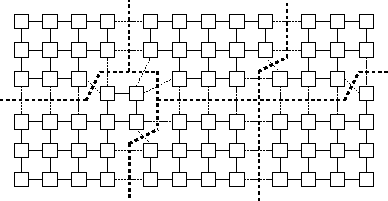
Figure 2.17: Load balancing in a grid problem. Variable numbers of
grid points are placed on each processor so as to compensate for load
imbalances. This sort of load distribution may arise if a local
load-balancing scheme is used in which tasks exchange load information
with neighbors and transfer grid points when load imbalances are
detected.
The techniques just described are relatively expensive because they
require global knowledge of computation state. In contrast, local
load-balancing algorithms compensate for changes in computational load
using only information obtained from a small number of neighboring
processors. For example, processors may be organized in a logical
mesh; periodically, each processor compares its computational load
with that of its neighbors in the mesh and transfers computation if
the difference in load exceeds some threshold. Figure 2.17
and
Plate 3
show load distributions produced by such
schemes.
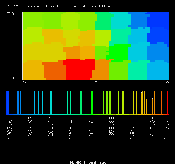
(GIF 27606 bytes; RGB 133673 bytes.)
Plate 3: A dynamic, local
load-balancing algorithm applied to a weather model. This shows the
situation after grid points have migrated to compensate for a ``hot
spot'' slightly to the left of the center of the grid. Image courtesy
of J. Michalakes.
Because local algorithms are inexpensive to operate, they can be
useful in situations in which load is constantly changing. However,
they are typically less good at balancing load than global algorithms
and, in particular, can be slow to adjust to major changes in load
characteristics. For example, if a high load suddenly appears on one
processor, multiple local load-balancing operations are
required before load ``diffuses'' to other processors.
A particularly simple approach to load balancing is to allocate tasks
to randomly selected processors. If the number of tasks is large, we
can expect that each processor will be allocated about the same amount
of computation. Advantages of this strategy are its low cost and
scalability. Disadvantages are that off-processor communication is
required for virtually every task and that acceptable load
distribution is achieved only if there are many more tasks than there
are processors. The strategy tends to be most effective when there is
relatively little communication between tasks and/or little locality
in communication patterns. In other cases, probabilistic methods
tend to result in considerably more communication than do other
techniques.
If we know both that computational load per grid point varies and that
there is significant spatial locality in load levels, then a
cyclic
(or scattered, as it is sometimes called) mapping
of tasks to processors can be appropriate. That is, each of
P
processors is allocated every P
th task according to some
enumeration of the tasks (Figure 2.18). This technique is a form of
probabilistic mapping. The goal is that, on average, each processor
will be allocated about the same computational load. The benefits of
improved load balance may need to be weighed against increased
communication costs due to reduced locality. Block cyclic
distributions are also possible, in which blocks of tasks are
allocated to processors.
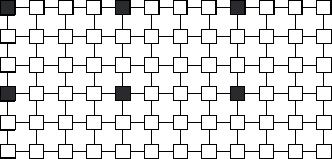
Figure 2.18: Using a cyclic mapping for load balancing in a grid
problem, when executing on 12 processors. Tasks mapped to a single
processor are shaded. Notice that with this mapping, all
communications are with tasks located on different processors
(assuming a five-point stencil).
Task-scheduling algorithms can be used when a functional decomposition
yields many tasks, each with weak locality requirements. A
centralized or distributed task pool is maintained, into
which new tasks are placed and from which tasks are taken for
allocation to processors. In effect, we reformulate the parallel
algorithm so that what were originally conceived of as tasks become
data structures representing ``problems,'' to be solved by a set of
worker tasks, typically one per processor.
The most critical (and complicated) aspect of a task-scheduling
algorithm is the strategy used to allocate problems to workers.
Generally, the chosen strategy will represent a compromise between the
conflicting requirements for independent operation (to reduce
communication costs) and global knowledge of computation state (to
improve load balance). We discuss manager/worker, hierarchical
manager/worker, and decentralized approaches.
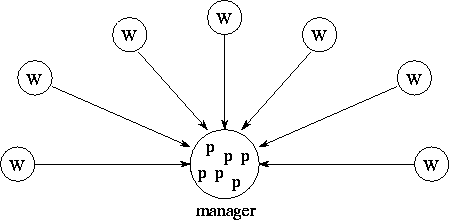
Figure 2.19: Manager/worker load-balancing structure. Workers
repeatedly request and process problem descriptions; the manager
maintains a pool of problem descriptions ( p) and responds to
requests from workers.
Figure 2.19 illustrates a particularly simple task scheduling
scheme that is nevertheless effective for moderate numbers of
processors. This strategy was used previously in
Section 1.4.4. A central manager task is given
responsibility for problem allocation. Each worker repeatedly
requests and executes a problem from the manager. Workers can also
send new tasks to the manager for allocation to other workers. The
efficiency of this strategy depends on the number of workers and the
relative costs of obtaining and executing problems. Efficiency can be
improved by prefetching problems so as to overlap computation and
communication, and by caching problems in workers, so that workers
communicate with the manager only when no problems are available
locally.
A variant of the manager/worker scheme divides workers into
disjoint sets, each with a submanager. Workers request tasks from
submanagers, which themselves communicate periodically with the
manager and with other submanagers to balance load between the sets of
processors for which they are responsible.
In completely decentralized schemes, there is no central manager.
Instead, a separate task pool is maintained on each processor, and
idle workers request problems from other processors. In effect, the
task pool becomes a distributed data structure that is accessed by the
different tasks in an asynchronous fashion. A variety of access
policies can be defined. For example, a worker may request work from
a small number of predefined ``neighbors'' or may select other
processors at random. In a hybrid centralized/distributed scheme,
requests are sent to a central manager, which allocates them to
workers in a round-robin fashion. Notice that while this manager will
certainly be a bottleneck on large numbers of processors, it will
typically be accessed less frequently than will the manager in a
manager/worker scheduler and hence is a more scalable construct.
As noted in Section 2.3.4, access to a distributed
data structure, such as the task pool maintained by a decentralized
load-balancing scheme,
can be provided in several different ways.
Workers can be made responsible for both computing and managing the
queue of problems. In this case, each worker must periodically
poll to detect pending requests. Alternatively, computation and
task pool management responsibilities can be encapsulated in separate
tasks.
Task-scheduling algorithms require a mechanism for determining when a
search is complete; otherwise, idle workers will never stop requesting
work from other workers. This termination
detection
operation is straightforward in centralized schemes,
because the manager can easily determine when all workers are idle.
It is more difficult in decentralized algorithms, because not only is
there no central record of which workers are idle, but also messages
in transit may be carrying tasks even when all workers appear to be
idle. See the chapter notes for references to termination-detection
algorithms.
We have now completed our parallel algorithm design by specifying how
tasks defined in previous design stages are mapped to processors. Our
mapping decisions seek to balance conflicting requirements for
equitable load distribution and low communication costs. When
possible, we use a static mapping scheme that allocates each task to a
single processor. However, when the number or size of tasks is
variable or not known until runtime, we may use a dynamic load
balancing scheme or reformulate the problem so that a task scheduling
structure can be used to schedule computation.
The following checklist can serve as a basis for an informal
evaluation of the mapping design.
-
If considering an SPMD design for a complex problem, have you also
considered an algorithm based on dynamic task creation and deletion?
The latter approach can yield a simpler algorithm (as will be
illustrated in Section 2.7); however, performance can be
problematic.
-
If considering a design based on dynamic task creation and deletion,
have you also considered an SPMD algorithm? An SPMD algorithm
provides greater control over the scheduling of communication and
computation, but can be more complex.
-
If using a centralized load-balancing scheme, have you verified that
the manager will not become a bottleneck? You may be able to reduce
communication costs in these schemes by passing pointers to tasks,
rather than the tasks themselves, to the manager.
-
If using a dynamic load-balancing scheme, have you evaluated the
relative costs of different strategies? Be sure to include the
implementation costs in your analysis. Probabilistic or cyclic
mapping schemes are simple and should always be considered, because they
can avoid the need for repeated load-balancing operations.
-
If using probabilistic or cyclic methods, do you have a large enough number
of tasks
to ensure reasonable load balance? Typically, at least ten
times as many tasks as processors are required.
We have now completed the design of one or more parallel algorithms
designs for our problem. However, we are not quite ready to start
writing code: several phases in the design process remain. First, we
need to conduct some simple performance analyses in order to choose
between alternative algorithms and to verify that our design meets
performance goals. We should also think hard about the implementation
costs of our designs, about opportunities for reusing existing code in
their implementation, and about how algorithms fit into larger systems
of which they may form a part. These issues are discussed in detail
in Chapters 3 and 4.
![[DBPP]](pictures//asm_color_tiny.gif)





![[Search]](pictures//search_motif.gif)
Next: 2.6 Case Study: Atmosphere Model
Up: 2 Designing Parallel Algorithms
Previous: 2.4 Agglomeration
© Copyright 1995 by Ian Foster

![[DBPP]](pictures//asm_color_tiny.gif)





![[Search]](pictures//search_motif.gif)

 . The algorithm first
identifies the two extremities of the graph, that is, the two vertices
that are the most separated in terms of graph distance. (The graph
distance between two vertices is the smallest number of edges that
must be traversed to go between them.) Each vertex is then assigned
to the subdomain corresponding to the closer extremity. Another
. The algorithm first
identifies the two extremities of the graph, that is, the two vertices
that are the most separated in terms of graph distance. (The graph
distance between two vertices is the smallest number of edges that
must be traversed to go between them.) Each vertex is then assigned
to the subdomain corresponding to the closer extremity. Another




